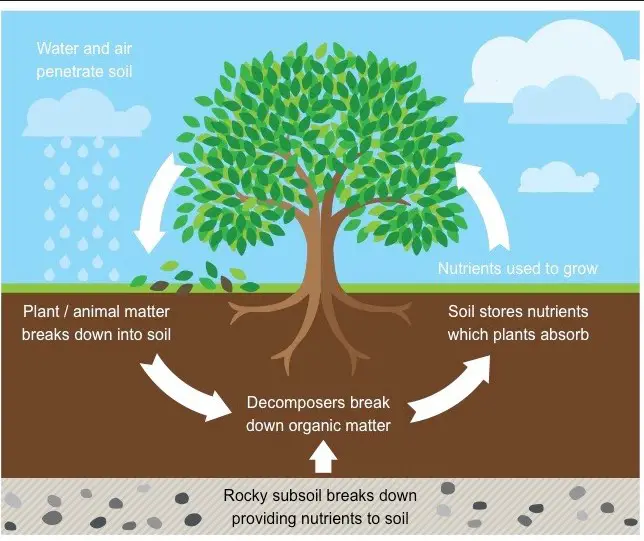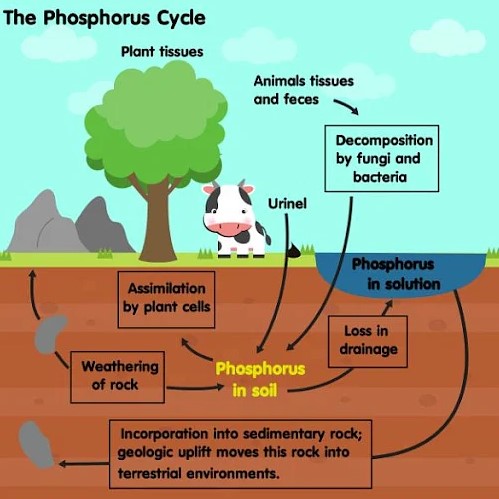Biogeochemical cycles are nature’s way of recycling the elements essential for life, from the air we breathe to the soil that nurtures our food. These cycles ensure the continuous movement of elements like carbon, nitrogen, and phosphorus through the Earth’s atmosphere, lithosphere, hydrosphere, and biosphere. However, not all biogeochemical cycles are created equal; they are broadly categorized into gaseous and sedimentary types, each playing unique roles in sustaining life on Earth.
The primary difference between gaseous and sedimentary biogeochemical cycles lies in their pathways and mechanisms for circulating elements. Gaseous cycles, such as the carbon and nitrogen cycles, involve the atmosphere as a major reservoir, allowing for a rapid and global exchange of elements. On the other hand, sedimentary cycles, like the phosphorus and sulfur cycles, primarily operate through the Earth’s crust, resulting in slower, more localized element movement.
While gaseous cycles are characterized by their vast, swift exchange across the globe, sedimentary cycles tend to be more grounded, with elements making their way through the soil and rocks. These fundamental differences affect everything from the availability of nutrients to organisms, to the impact on global climate patterns. By understanding these cycles, we can better appreciate the complex interplay of elements that sustain life and the planet’s delicate balance.

Cycle Basics
What are Biogeochemical Cycles?
Biogeochemical cycles represent the pathways through which essential elements and compounds necessary for life circulate through the ecosystem. These cycles connect the atmosphere, lithosphere, hydrosphere, and biosphere in a complex web of processes that support life on Earth. Their significance cannot be overstated; they regulate the environment, ensure the availability of essential nutrients, and maintain ecological balance.
Types of Cycles
There are two main types of biogeochemical cycles: gaseous cycles and sedimentary cycles. Each plays a unique role in the Earth’s ecosystems.
Gaseous Cycles
Gaseous cycles primarily involve the atmosphere and hydrosphere, allowing for rapid and global distribution of elements. Carbon, nitrogen, and oxygen cycles are prime examples.
Sedimentary Cycles
Sedimentary cycles involve the Earth’s crust, making them slower and more localized. These cycles include the phosphorus and sulfur cycles, crucial for soil fertility and microbial life.
Gaseous Cycles
Overview
Gaseous cycles are characterized by their global reach and speed. They play a critical role in regulating the Earth’s climate and supporting life by circulating elements like carbon, nitrogen, and oxygen.
Characteristics and Examples
- Global distribution: These cycles operate on a planetary scale.
- Rapid movement: Elements move swiftly through these cycles.
- Essential for life: They regulate oxygen levels, climate, and soil fertility.
Carbon Cycle
Process and Impact
The carbon cycle is a series of processes by which carbon compounds are interconverted in the environment. It includes:
- Photosynthesis: Plants convert CO2 into glucose.
- Respiration: Organisms release CO2 back into the atmosphere.
- Decomposition: Decomposers break down dead matter, releasing carbon.
- Combustion: Burning fossil fuels releases stored carbon.
The carbon cycle is crucial for regulating Earth’s temperature and climate.
Nitrogen Cycle
Process and Environmental Role
The nitrogen cycle is the biogeochemical cycle that transforms nitrogen and nitrogen-containing compounds. Key processes include:
- Nitrogen fixation: Atmospheric nitrogen is converted into a usable form for plants.
- Ammonification: Decomposition produces ammonia from organic matter.
- Nitrification: Ammonia is converted to nitrites and nitrates.
- Denitrification: Nitrates are converted back into nitrogen gas.
This cycle is essential for protein synthesis and ecosystem productivity.
Oxygen Cycle
Mechanism and Importance
The oxygen cycle involves the movement of oxygen within and between the Earth’s atmosphere, biosphere, and lithosphere. It includes:
- Photosynthesis: Oxygen is produced.
- Respiration: Oxygen is consumed.
- Decomposition: Affects oxygen availability and use.
Oxygen is vital for respiration and supports aerobic life forms.
Sedimentary Cycles
Overview
Sedimentary cycles focus on the Earth’s crust, moving elements through soil and rocks. They are slower but essential for soil nutrition and ecosystem health.
Characteristics and Examples
- Local impact: Primarily affect localized areas.
- Slow movement: Elements circulate more slowly than in gaseous cycles.
- Crucial for ecosystems: Support soil fertility and water quality.
Phosphorus Cycle
Steps and Significance
The phosphorus cycle describes the movement of phosphorus through the lithosphere, hydrosphere, and biosphere. Key steps include:
- Weathering: Phosphorus is released from rocks.
- Absorption: Plants absorb phosphorus from the soil.
- Consumption: Animals obtain phosphorus by eating plants.
- Decomposition: Phosphorus returns to the soil or water bodies.
Phosphorus is vital for DNA, RNA, and ATP in living organisms.
Sulfur Cycle
Process and Ecosystem Influence
The sulfur cycle is the collection of processes by which sulfur moves between rocks, waterways, and living systems. It involves:
- Mineral dissolution: Releases sulfur into the soil.
- Assimilation: Plants absorb sulfur, which then moves up the food chain.
- Deposition: Volcanic activity and decay return sulfur to the ground and water.

Key Differences
Process Variations
Pathways and Transformations
The fundamental distinction between gaseous and sedimentary biogeochemical cycles lies in their pathways and mechanisms. Gaseous cycles, such as the carbon and nitrogen cycles, primarily involve the atmosphere and enable rapid global distribution of elements. This swift movement allows for quick responses to changes within the ecosystem.
In contrast, sedimentary cycles, like the phosphorus and sulfur cycles, are grounded in the Earth’s crust. Their pathways are slower, relying on weathering of rocks and soil processes to recycle nutrients. This results in a more localized effect on ecosystems but is crucial for long-term soil fertility and water quality.
Environmental Impact
Role in Climate Change and Ecosystems
Gaseous and sedimentary cycles play significant roles in regulating the Earth’s climate and supporting diverse ecosystems. The carbon cycle, a gaseous process, is directly linked to climate change through the greenhouse effect. Excessive carbon dioxide and methane in the atmosphere trap heat, altering global temperatures and weather patterns.
Sedimentary cycles like the phosphorus cycle have a profound impact on water ecosystems. Eutrophication, caused by the runoff of excess nutrients into bodies of water, leads to harmful algal blooms that deplete oxygen, harming aquatic life.
Human Influence
Pollution and Cycle Disruption
Human activities significantly disrupt both types of cycles. The burning of fossil fuels accelerates the carbon cycle, releasing vast amounts of CO2 and contributing to global warming. Similarly, industrial and agricultural practices introduce excessive nitrogen and phosphorus into the environment, disturbing the natural balance of these cycles.
Case Studies
Comparing Cycles in Ecosystems
Forest vs. Oceanic Cycles
Forests and oceans serve as critical reservoirs in gaseous cycles. Forests, through photosynthesis, are major absorbers of CO2, while oceans act as carbon sinks, absorbing a significant portion of atmospheric CO2. The dynamics in these ecosystems are crucial for maintaining atmospheric balance.
In contrast, sedimentary cycles operate differently in these environments. Oceans play a key role in the sulfur cycle, with volcanic eruptions and decaying organic matter contributing to sulfur exchanges. Forest ecosystems, meanwhile, highlight the phosphorus cycle’s importance, as trees absorb phosphorus from the soil, which is then recycled back into the environment through leaf litter and decomposition.
Impact of Human Activities
Fossil Fuels and Agriculture
The extraction and combustion of fossil fuels release carbon and sulfur into the atmosphere, impacting both gaseous and sedimentary cycles. Agriculture, particularly the use of fertilizers, disrupts the nitrogen and phosphorus cycles, leading to nutrient runoff and eutrophication in nearby water bodies.
Mitigation Strategies
Sustainable Practices
Reducing Emissions and Enhancing Cycles
To mitigate the adverse effects on biogeochemical cycles, adopting sustainable practices is crucial. This includes:
- Reducing carbon footprint: Through energy efficiency and renewable energy sources.
- Sustainable farming: Implementing practices that minimize fertilizer use and enhance soil health.
- Reforestation: Planting trees to absorb CO2 and improve soil structure for the phosphorus and nitrogen cycles.
Technological Innovations
Capture and Recycling Techniques
Technological advancements offer promising solutions for mitigating human impacts on biogeochemical cycles. Techniques such as carbon capture and storage (CCS) can significantly reduce CO2 levels in the atmosphere. Similarly, innovations in recycling wastewater can recover nutrients, preventing eutrophication and supporting sustainable agriculture.
Frequently Asked Questions
What Are Biogeochemical Cycles?
Biogeochemical cycles refer to the natural processes that recycle elements essential for life through the Earth’s ecosystems. These cycles ensure the movement of elements such as carbon, nitrogen, oxygen, phosphorus, and sulfur from the environment to living organisms and back, thus maintaining the planet’s equilibrium and supporting life.
Why Are Gaseous Cycles Faster Than Sedimentary Cycles?
Gaseous cycles are faster than sedimentary cycles mainly because they involve the atmosphere as a major reservoir, allowing for the quick and global distribution of elements. In contrast, sedimentary cycles rely on the Earth’s crust, where elements move more slowly through soil and rock, making the cycle time considerably longer.
How Do Human Activities Impact Biogeochemical Cycles?
Human activities, including fossil fuel combustion, deforestation, and intensive agriculture, significantly impact biogeochemical cycles. These actions can lead to increased greenhouse gas emissions, disruption of the nitrogen and phosphorus cycles, and a loss of biodiversity, thereby affecting climate regulation, soil fertility, and the overall health of ecosystems.
Conclusion
Biogeochemical cycles form the backbone of Earth’s life-support systems, facilitating the circulation of crucial elements in various forms across different planetary domains. Understanding the distinction between gaseous and sedimentary cycles not only enriches our knowledge of Earth’s complex environmental mechanisms but also underscores the importance of maintaining these cycles’ integrity in the face of human-induced pressures.
As we continue to study and interact with these cycles, it becomes clear that our actions have profound effects on the natural processes that sustain life on our planet. By recognizing the critical role of both gaseous and sedimentary cycles in regulating the environment, we can adopt more sustainable practices to ensure the health and continuity of life for future generations.
